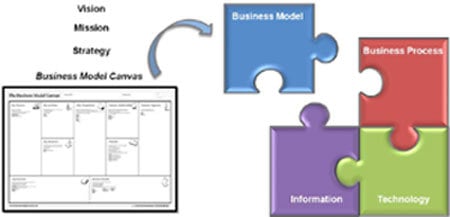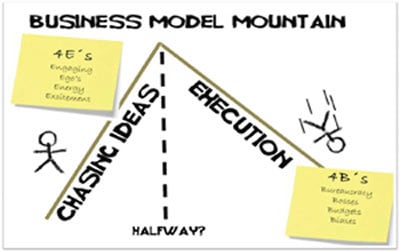Absolutely nothing, and I still stand by what I said. If anything, ample proof exists in the growing number of user communities and tools (e.g. Business Model Fiddle and Lean Canvas) that employ this amazing technique to simplify and facilitate their business model innovations. However, the one missing piece for me was how to easily translate valuable insights gleaned from using the business model canvas into something tangible, practical and immediately applicable to the actual work of business transformation. That problem appears to have been solved with the introduction of tools that can automate and facilitate the execution part of business model innovation.

Figure - The missing piece: executing business model innovation
Don’t get me wrong, the above missing piece is achievable by manually translating business model changes into the enterprise architecture (EA) and business process (BPM) landscape, but this implies hefty overheads in terms of people and effort required to implement even a simple change. Also, the evolving nature of the role played by EA and BPM functions, (within a dynamic and fast changing business environment), demands a more seamless interface with changing business models. Thankfully, the afore-mentioned tools should help to automate and provide such seamless linkage.
A couple of weeks ago, I attended a vendor webinar that prompted this blog post, because they described how their software suite was designed to deliver this capability, and below are some of my impressions from that event, including:
- The promise of business model canvas as the right approach to address the challenge of a volatile, uncertain, complex and ambiguous (aka VUCA) world.
- The shift away from products to business models as key differentiators
- Seven applications of the business model canvas, including various business model innovation journeys and perspectives (e.g. offer / customer / revenue driven models)
- Business model mountain was the term used to describe how business model innovation falls over halfway between ideation and execution, (see diagram below).

Figure - Business model mountain (source: BizzDesign Webinar Slides)
According to the presenter, their software suite provide a more compelling way to engage business stakeholders with the end-to-end transformation process, by using business model canvas as the reference model for communication between business, process and technology stakeholders. It was also great to see a demo of the software suite, which allayed some of my fears about tools that attempt to do too much, by featuring different aspects (i.e. business model canvas, EA and BPM) as distinct tools that work well in their own right, but which can be combined to deliver end-to-end translation of the business model into real system components and processes.
Health warning: Not having used this tool yet, (due to very busy day job, believe it or not), I’m unable to say more about real hands-on capabilities, but in terms of its potential to help realise the huge promise and benefits of business model innovation, this is certainly a step in the right direction, in my humble opinion.
Note: this is another post in the innovation topic series, and more specifically, “tools for innovation”. Watch out for more on this and related topics, over the next few months.












